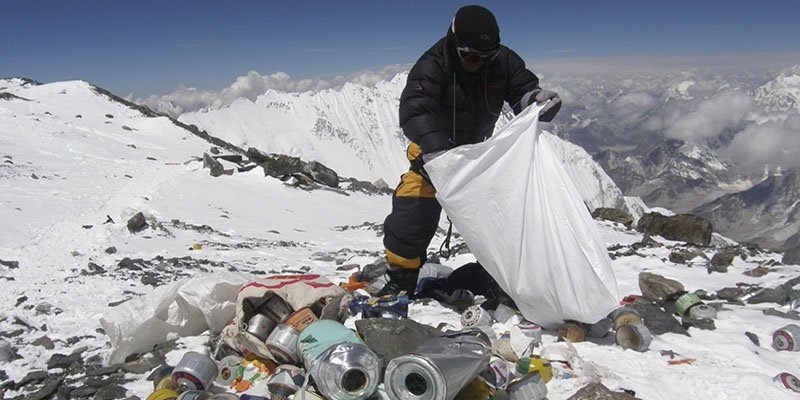Cleaning up of the Everest region

- 24-Mar-2016
- 0
If you are an enthusiastic adventurer, you might definitely have the Everest Base Camp Trek as the prime destination for trekking. Since the summit by Sir Edmund Hillary and Tenzing Norgay in 1953, more than 3000 adventurers have ascended Everest and several thousand have completed the trekking in the Everest Region. Besides the natural difficulties and calamities that take place in the Everest region, one of the most prominent risk factor in the Everest trek, wastes and filth left behind by the climbers, researchers, scientists, movie and documentary producers, photographers and visitors, and trekkers like you are posing another serious environmental issue in the region.
Nepal’s other Everest!
Wastes! The piles of garbage and wastes in Everest are forming another Everest in the region; the mountain of garbage. If you are a member of the Everest Base Camp Trek in the peak season, you can see several other trekkers and mountaineers who are as eager as you to enjoy in the vicinity of the region or ascend the tallest peak in the world. Imagine the number of wastes left produced when several hundred trekkers wander along the trails in the Everest region which also includes the trekking to the Gokyo region and Island Peak along with the other popular trekking destinations.
A single climbing season in Everest produces more than 12000 kg of solid human waste. When trekkers and their guides or porters and mountaineers along with the Sherpas reach the vicinity of Everest they leave their footprints and also the wastes in the spots like Gorakshep; wastes are left in the region above 8000m by the climbers. A report by BBC News and SKY news in 2010 featured the tourism officials collecting the trashes in the Everest region. In 2011 alone, expeditions brought down a total of 8.1 tons of wastes and garbage collected from the mountains and its trekking trails.
Torn tents, oxygen cylinders, human wastes, plastics, and other non-degradable garbage, left out gears and equipment, bottles and barrels used for different purposes utensils, pots and pans, kerosene and wrappers, and cooking materials, dead bodies of climbers in the region in death-zone or altitude above 8000m are the major components of the garbage and wastes that pollute the Everest regions and its trek route. You can’t leave the wastes up in Everest and its trails just like that!

Cleaning ain’t easy
You heard me right. While we talk about the wastes that get piled up in the Everest region including the mighty Everest, cleaning up the wastes and disposing of it properly can’t be done single-handedly by any one of the many stakeholders.
Bringing the heavy oxygen cylinders left behind by other climbers during their expeditions along with the equipment and gears of their own expedition from an altitude above 8000 meters is a herculean task. Logistic difficulty and weather condition along with the limitations of human capability makes the cleaning task a difficult task.
The trekkers generally are in the tea-house trekking which makes waste management relatively easy. However, the Himalayan adventures which go for camping as well as with some independent trekkers who don’t follow proper guidelines for waste management and prevention are generally more responsible for polluting the pristine environment of the Everest region. Monitoring them through the existing weak institutional strength of government is a challenge for environmental conservation in the region.
What happens to the waste?
Besides the problems we talk about, another big question you might be thinking about is what happens to the waste even if you collect the waste in the Khumbu region? There is no proper waste disposal facility in the region. This makes waste management more difficult. The trash is sorted with the non-recyclable material stored currently in the town of Khumjung. The wastes collected from the Everest treks can be managed by segregating the degradable and non-degradable wastes. Human wastes can be disposed of by coordinating with the local teahouses.
Efforts made and Solutions ahead
Sagarmatha Pollution Control Committee (SPCC), a local NGO, is responsible to manage waste in the region. Some of the wastes collected in the region are then carried on to Lukla from where they will be flown to Kathmandu. There are some creative efforts to manage the waste and reduce the impact of garbage in the Everest region.
Some of the efforts towards the cleaning up Everest trek route and the Everest region, in general, may be listed in the following points.
- New national policies on waste management and code of conduct for National Parks in Nepal
- Plastic bags have been banned from the project region since May 2011.
- Lodge-owners, shop keepers and farmers have been trained in waste prevention and awareness on waste management has been raised
- Biogas projects in the Everest region that breaks down the human waste and creates a clean-burning methane gas for the Sherpa community in the region
- Exchanging the trash for cash as conducted by some trekking agency in which they provide cash to anyone who brings waste to them
- Encouraging alternative energy solutions for cooking, water purification, the proper drainage system in the teahouses along the region, and waste management.
- Setting up of the solid waste collection bins and collection centers along the trails and regular disposal of such collected wastes
Everest is the pride of Nepal as much as it is the treasure of the whole world. Cleaning up the Everest and the trails of the region is very essential for preserving the natural environment and the source of income for the region, which primarily relies on tourism. When the trails are filthy, will the trekkers like you come for Everest Base Camp Trek? Think about the issue. So, it's high time we do an effort to keep the Everest region clean and pristine.




